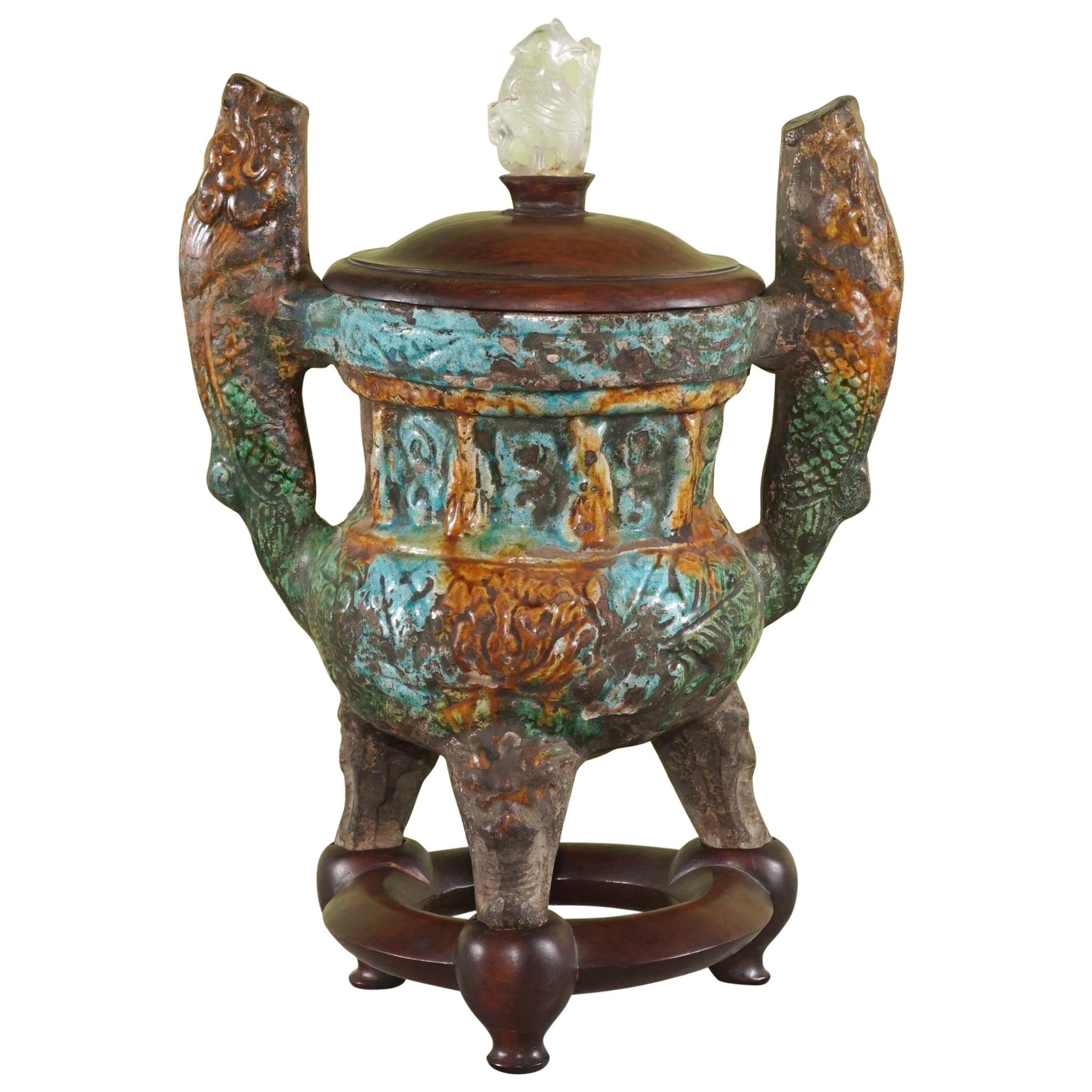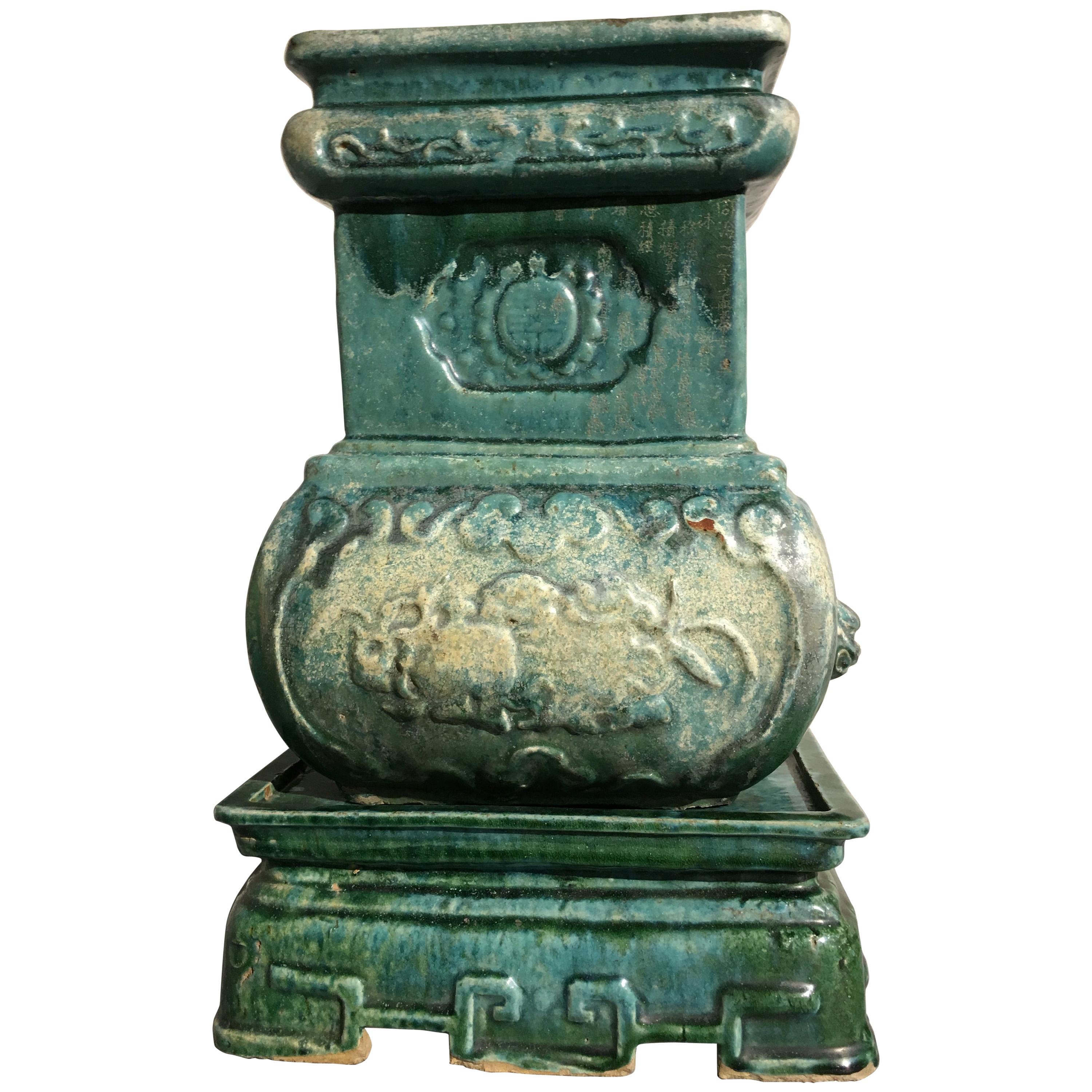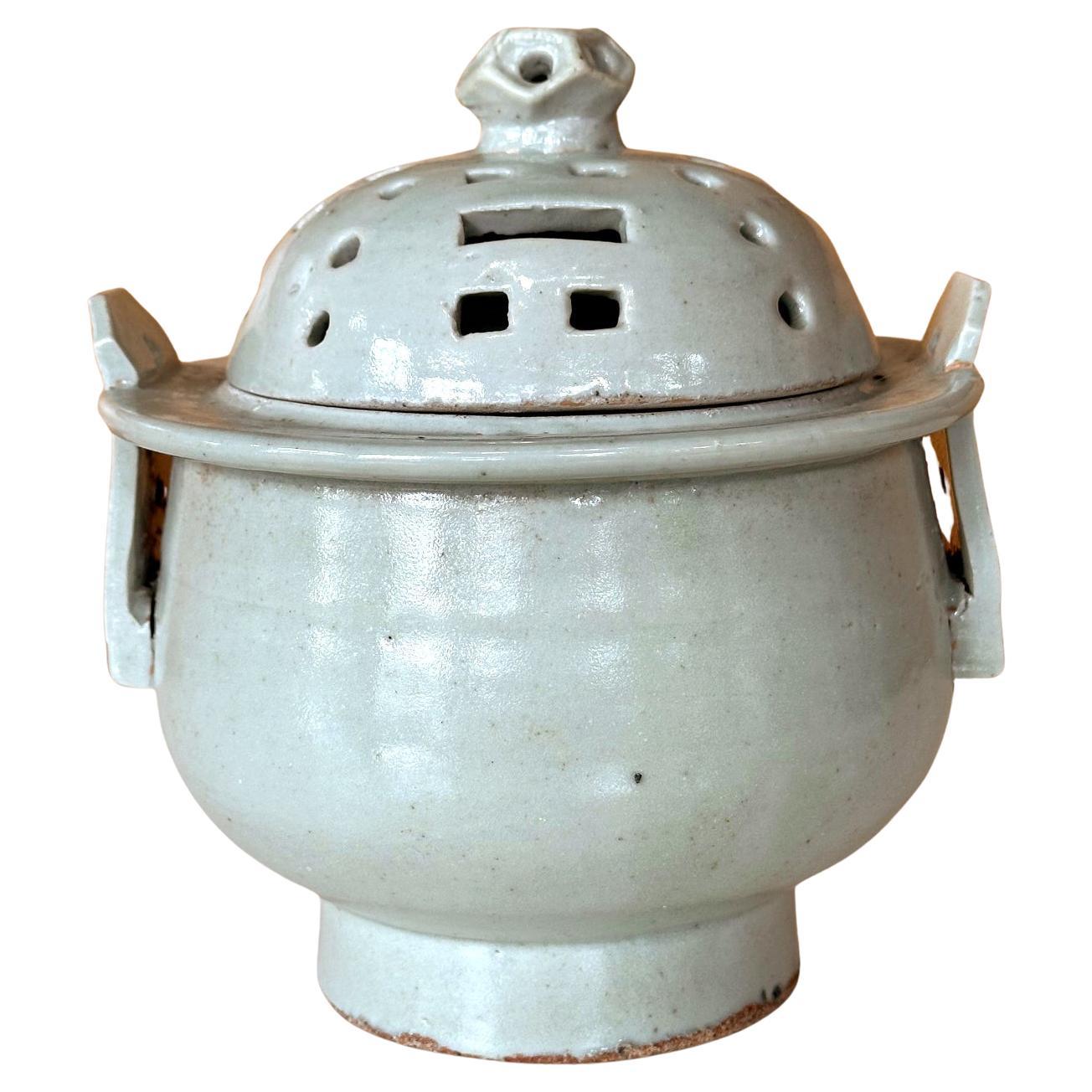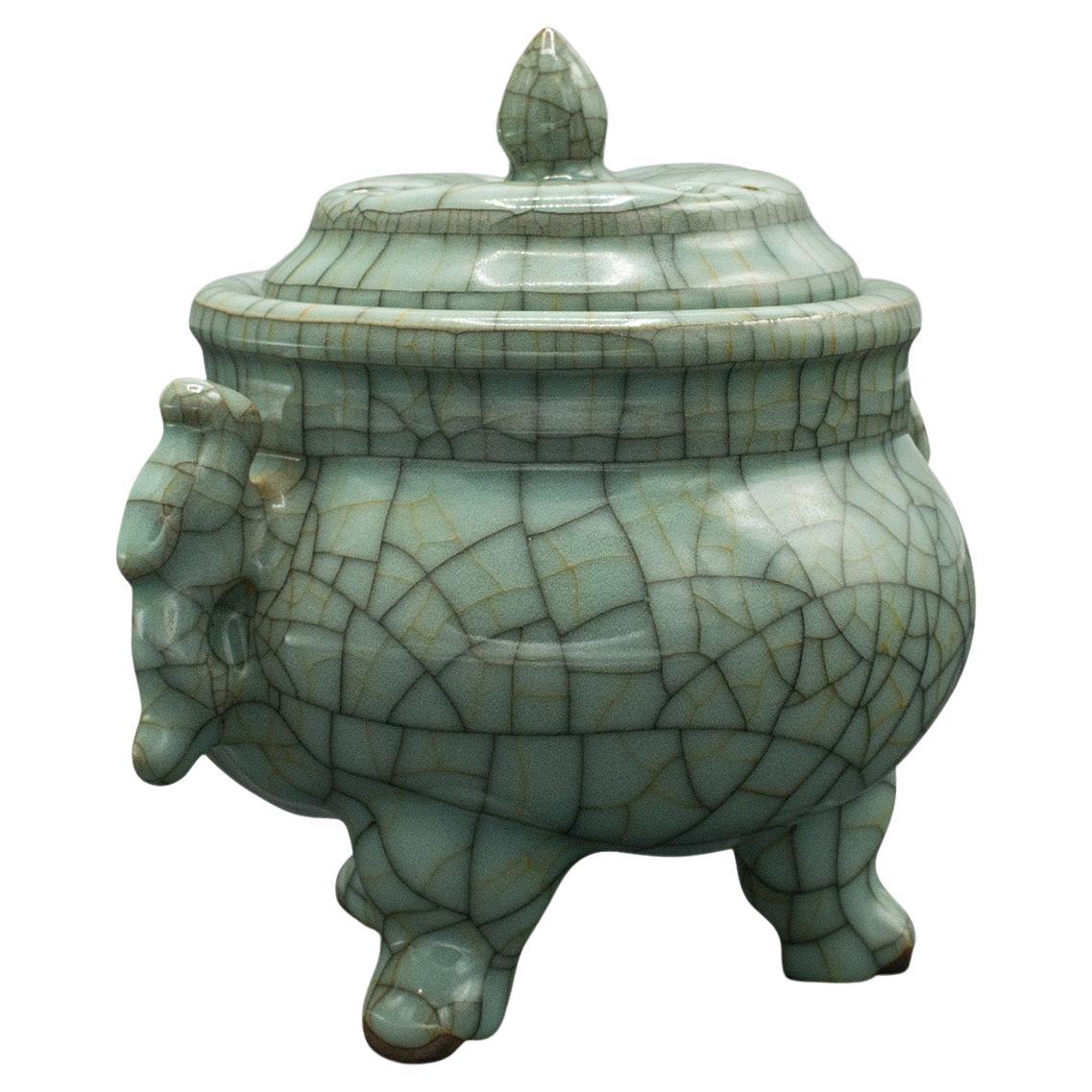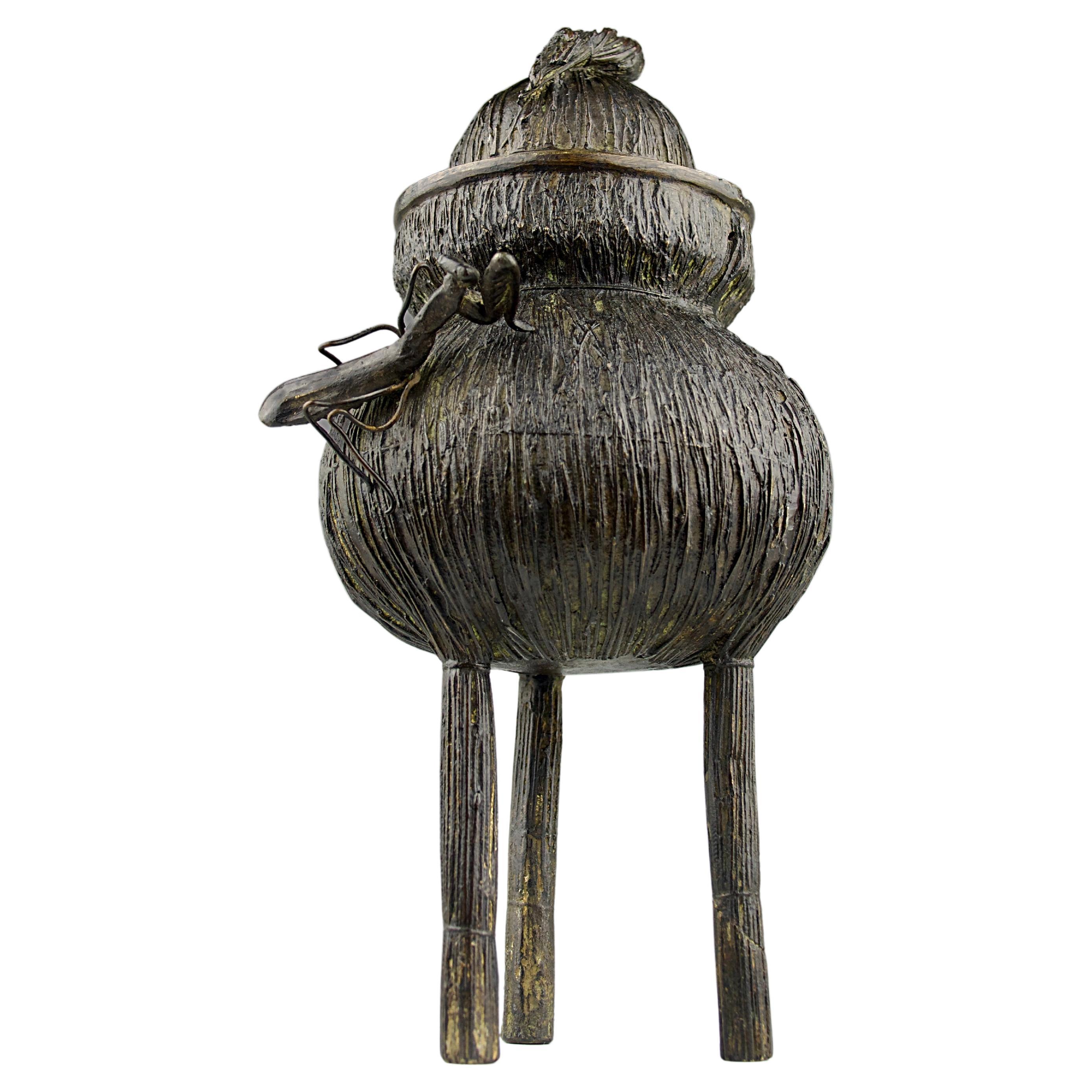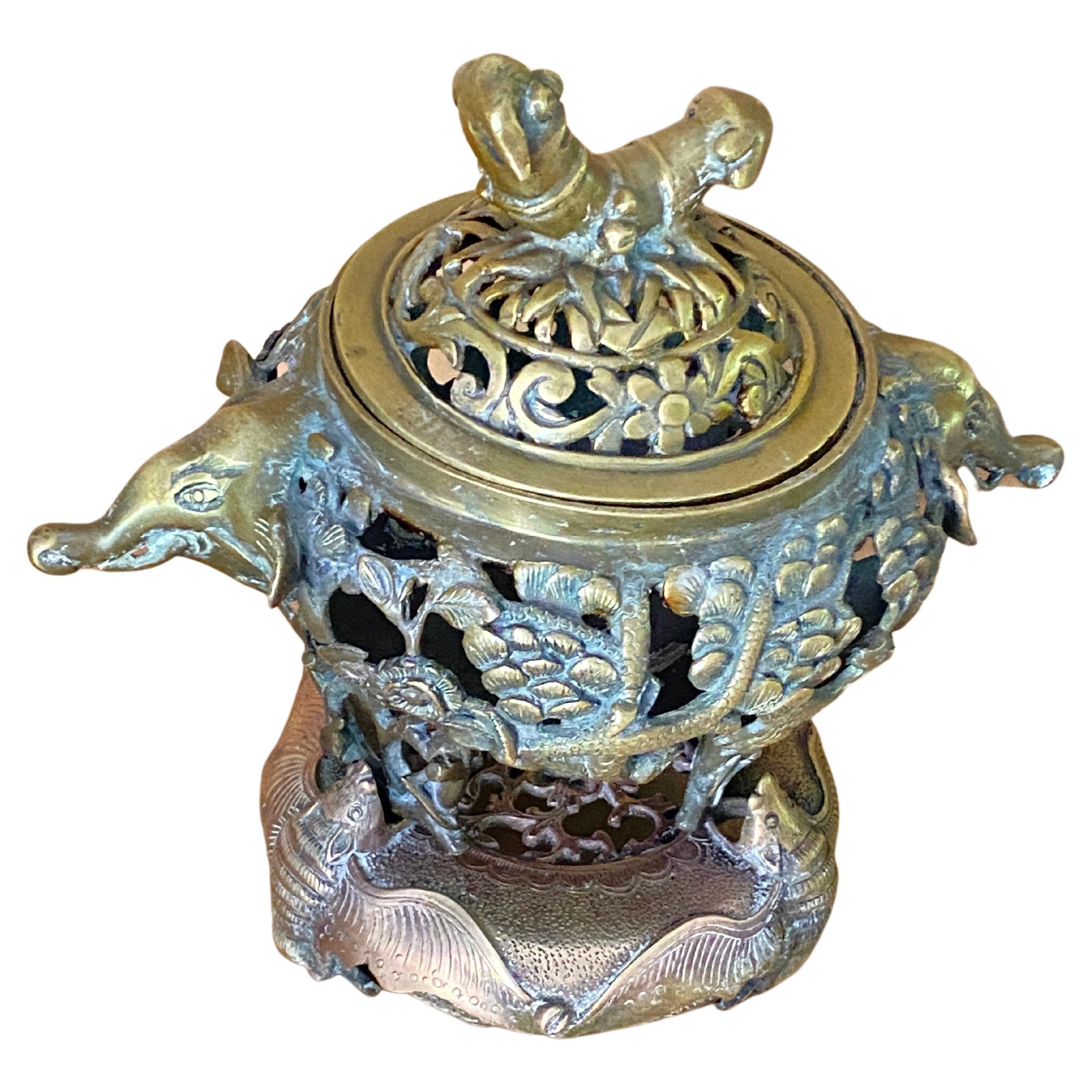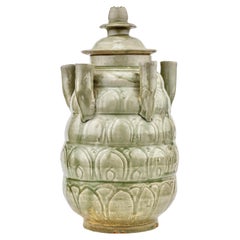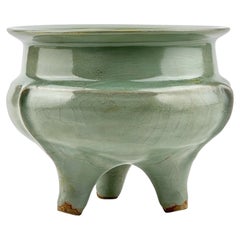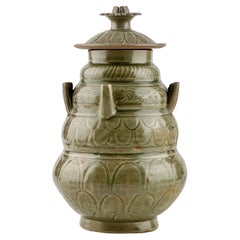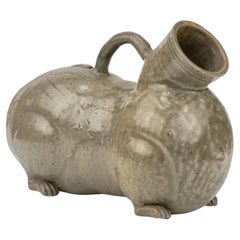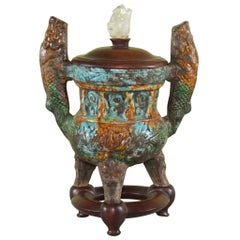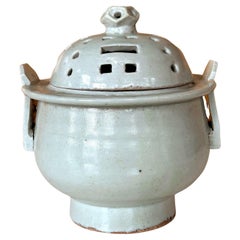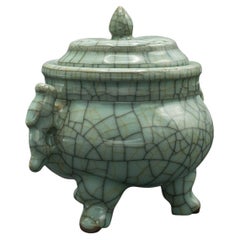Items Similar to Rare Boshan Incense Burner Yue Celadon, Jin dynasty
Want more images or videos?
Request additional images or videos from the seller
1 of 21
Rare Boshan Incense Burner Yue Celadon, Jin dynasty
$5,960
$14,90060% Off
£4,522.31
£11,305.7860% Off
€5,170.86
€12,927.1560% Off
CA$8,324.50
CA$20,811.2660% Off
A$9,255.72
A$23,139.2960% Off
CHF 4,832.82
CHF 12,082.0660% Off
MX$112,664.60
MX$281,661.4960% Off
NOK 61,664.73
NOK 154,161.8260% Off
SEK 57,776.91
SEK 144,442.2660% Off
DKK 38,591.07
DKK 96,477.6660% Off
Shipping
Retrieving quote...The 1stDibs Promise:
Authenticity Guarantee,
Money-Back Guarantee,
24-Hour Cancellation
About the Item
The Boshan incense burner is particularly notable among Han dynasty incense burners for its unique shape. Designed to resemble a mountain or even a mythical mountain, it is characterized by its pointed peaks that rise upwards. These peaks often function as vents for the smoke, creating an effect reminiscent of a volcanic eruption.
The body of the incense burner is typically round, with multiple small peaks surrounding a central, larger peak. The material used is mainly ceramic, although there are instances where they were made of bronze. It is presumed that this incense burner was used for religious or ceremonial purposes during its time. The colors of these burners are usually in shades of pale green or greyish brown, with the application of glaze to achieve a variety of colors on occasion.
Such incense burners are often found in tombs or ritual sites, and their purpose was to burn incense for purification of space or to produce pleasant aromas. The Boshan incense burner also represents a significant cultural heritage, showcasing the craftsmanship and artistic values of the period. Today, it is considered a quintessential example of ancient Chinese art.
Period : Han-Jin Dynasty
Type : Incense Burner
Medium : Yue celadon(Stoneware)
Size : 17cm(Height), 12cm(Diameter)
Provenance : The piece was acquired in Hong Kong in the year 1999.
Condition : Good
Reference :
1) Smithsonian National Museum of Asian Art, Washington D.C. - ACCESSION NUMBER:S2012.9.3624a-b
2) National Museum of China
3) The Museum of East Asian Art, China
* Boshan and Eastern Culture
The Boshan incense burner’s design, which mimics a mountain, is especially symbolic. Mountains have long been considered sacred in Chinese culture, representing closeness to the heavenly realm. They are often depicted as the abode of immortals and deities. The mountain-shaped Boshan incense burner serves as a microcosmic representation of these holy mountains, with the smoke mimicking cloud and mist surrounding the peaks, enhancing the sacred ambiance during rituals.
In Confucianism, another significant aspect of Chinese culture, ritual and ancestor worship are central. Incense burners were used in ancestral rites to honor and remember the deceased. The pleasing aroma of incense was believed to summon the spirits of ancestors, allowing the living to pay their respects and seek guidance or blessings.
The Boshan incense burner would have been an important object in burial practices as well. Placed in tombs, they served both as items for the afterlife and as a means to provide a fragrant journey for the departed to the afterlife. This reflects the ancient Chinese belief in an ongoing relationship between the living and the dead.
The artistic and functional aspects of the Boshan incense burner reflect the fusion of spiritual symbolism, cultural practices, and the sophisticated aesthetic values of the time. It stands as a testament to the importance of incense in ritualistic practices and the broader cultural and religious landscape of ancient China.
- Dimensions:Height: 6.7 in (17 cm)Diameter: 4.73 in (12 cm)
- Style:Han (Of the Period)
- Materials and Techniques:
- Place of Origin:
- Period:
- Date of Manufacture:2th-4th Century
- Condition:Minor fading. Various minor scratches. It was confirmed that few of the horns had been repaired a very long time ago and had become discolored.
- Seller Location:seoul, KR
- Reference Number:1stDibs: LU9577238612172
About the Seller
4.8
Gold Seller
Premium sellers maintaining a 4.3+ rating and 24-hour response times
Established in 1999
1stDibs seller since 2023
38 sales on 1stDibs
Typical response time: <1 hour
- ShippingRetrieving quote...Shipping from: seoul, Korea South
- Return Policy
Authenticity Guarantee
In the unlikely event there’s an issue with an item’s authenticity, contact us within 1 year for a full refund. DetailsMoney-Back Guarantee
If your item is not as described, is damaged in transit, or does not arrive, contact us within 7 days for a full refund. Details24-Hour Cancellation
You have a 24-hour grace period in which to reconsider your purchase, with no questions asked.Vetted Professional Sellers
Our world-class sellers must adhere to strict standards for service and quality, maintaining the integrity of our listings.Price-Match Guarantee
If you find that a seller listed the same item for a lower price elsewhere, we’ll match it.Trusted Global Delivery
Our best-in-class carrier network provides specialized shipping options worldwide, including custom delivery.More From This Seller
View AllLongquan Celadon Five-Spouted Jar, Northern Song Dynasty (AD 960~1127)
Located in seoul, KR
Thickly potted with an ovoid body of five horizontal lobes tapering toward the top, carries both aesthetic and practical values. The jar is intricately carved with rows of upright lo...
Category
Antique 15th Century and Earlier Hong Kong Antiquities
Materials
Celadon
$1,885 Sale Price
35% Off
Rare Longquan Celadon Tripod Incense Burner, Song-Yuan Dynasty
Located in seoul, KR
The vessel features a compressed body supported by three tapered feet and a flat, outwardly flaring rim. Three slender flanges originate from a subtle ridge on the shoulder and exten...
Category
Antique 15th Century and Earlier Hong Kong Antiquities
Materials
Celadon
$17,500 Sale Price
50% Off
A Longquan Celadon Five-spouted Jar, Northern Song Dynasty (960~1127)
Located in seoul, KR
The jar features a round body with well-proportioned four distinct tiers and a short, stable foot. The surface is coated in a deep green Longquan celadon glaze, showcasing the sprout...
Category
Antique 15th Century and Earlier Hong Kong Antiquities
Materials
Celadon
$6,175 Sale Price
35% Off
Rare Yue Celadon-Glazed Figural Vessel, Western Jin dynasty (265-420)
Located in seoul, KR
This vessel is well-modeled as a recumbent winged lion with detailed decorative elements. It features a grimacing face with large protruberant eyes under heavy brows and a gaping mou...
Category
Antique 15th Century and Earlier Hong Kong Han Antiquities
Materials
Celadon
$7,950 Sale Price
50% Off
A Rare Longquan Celadon 'Hundred Rib' Jar, Song-Yuan Dynasty
Located in seoul, KR
This beautifully crafted jar features a wide baluster form, swelling gracefully from a short and slightly tapered foot. The design is accentuated by slender, elegant vertical ribs th...
Category
Antique 15th Century and Earlier Hong Kong Antiquities
Materials
Celadon
$15,000 Sale Price
25% Off
Carved 'Longquan' Celadon-glazed Funerary vase and cover, Song dynasty
Located in seoul, KR
The vase features a ribbed body, subtly enhancing its graceful contours, and is topped with a uniquely sculpted lid adorned with figurative elements.
Period : Song Dynasty
Type : Ce...
Category
Antique 15th Century and Earlier Hong Kong Antiquities
Materials
Celadon
$3,995 Sale Price
50% Off
You May Also Like
Chinese Ming period Dynasty Buddhist Incense Burner with a Rock Crystal Finial
Located in Hudson, NY
The Ming period or Great Ming Period is the last Han ruled dynasty in Chinese history. Considers a high mark culturally and influenced by great events at ho...
Category
Antique 16th Century Chinese Ming Ceramics
Materials
Rock Crystal
Chinese Qing Dynasty Green Glazed Pottery Incense Burner, Dated 1863
Located in Austin, TX
A gorgeous green glazed large Chinese pottery censer of Archaistic shape called a fanghu, set on a separate stand, Qing dynasty, second year of Tongzhi, 1863.
The censer or incense burner crafted in two parts and covered in a thick, runny and unctuous glaze, ranging from dark green to turquoise green, to pale celadon. The neck with shou (longevity) medallions. The body decorated in relief with fruit, pomegranate and finger citron (Buddha's hand). The sides fitted with lion mask handles. The stand with a key fret design, and a pierced Chinese...
Category
Antique 1860s Chinese Qing Ceramics
Materials
Pottery
Korean Celadon Ritual Incense Burner Joseon Dynasty
Located in Atlanta, GA
An antique Korean ritual incense burner circa 19th century (late Joseon dynasty). This type of porcelain incense burner was made in Bunwon Kiln in Gwangju, Gyeonggi Do, near Seoul. U...
Category
Antique 19th Century Korean Archaistic Ceramics
Materials
Ceramic
Vintage Oriental Censer, Chinese, Celadon, Incense Burner, Art Deco, Circa 1940
Located in Hele, Devon, GB
This is a vintage Oriental censer. A Chinese, celadon incense burner, dating to the late Art Deco period, circa 1940.
Enthusiastically decorated wit...
Category
Mid-20th Century Chinese Decorative Bowls
Materials
Celadon
Incense Burner, Japan, 19th Century
Located in PARIS, FR
Beautiful incense burner in the shape of a straw basket with a praying mantis sitting on top. Bronze, Japan 19th century.
Good condition, oxidation, one leg missing from the prayi...
Category
Antique Mid-19th Century Japanese Meiji Urns
Materials
Bronze
Incense Burner, Bronze Chinese, 20th Century, Gold Color
Located in Auribeau sur Siagne, FR
Incense burner, bronze. It was made in China in the 20th century. One can notice elephants, bats and pine trees as decoration. It comes apart in three parts, and can of course be use...
Category
20th Century Chinese Chinese Export More Asian Art, Objects and Furniture
Materials
Bronze
$335 Sale Price
20% Off
More Ways To Browse
Antique Burners
Antique Incense
Incense Burners
Large Celadon
Asian Deity
Chinese Incense
Chinese Ancestral
Bronze Incense
Chinese Incense Burner
Han Dynasty Bronze
Large Incense Burner
Small Incense Burner
Chinese Bronze Incense Burner
Chinese Incense Stand
Large Bronze Incense Burner
Celadon Incense
Vung Tau Cargo
Northern Wei
